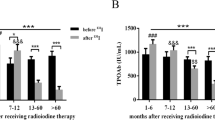Abstract
“Sensitive” thyrotropin (TSH), thyroglobulin (TG) and even thyrotropin binding inhibiting immunoglobulins (TBII) assays are now widely available. The objective of the present study was to determine the most accurate of these three parameters to predict the relapse of Graves’ disease during the year following treatment discontinuation and to evaluate whether the assay of three markers is able to improve the prediction. TSH, TG and TBII were measured in the sera of 67 Graves’ disease patients after at least 12 months of medical treatment. In 52 patients, TBII had also been determined before the beginning of the medical treatment. Under treatment, all the patients were clinically and biologically euthyroid, but in 9 goitrous patients it was impossible to lower the doses of carbimazole without an immediate relapse. The TSH levels of these 9 patients were still low in all cases but one; TG and TBII levels were abnormal in all. In the other 58 patients, the treatment was discontinued; 22 relapsed within one year, more frequently when a goiter was present. The most reliable parameter for the prediction of relapse was found to be TBII, as its specificity was high (94.5%), although its sensitivity was poor (45%); TG was more sensitive (64%) but far less specific (57%); TSH and “initial” TBII appeared to be of a little interest. When TBII was elevated prior to the withdrawal of treatment, the determination of TG was useful: abnormal values of both TBII and TG were always associated with a relapse. When TBII testing was negative, the relapse risk fell to 0.26, and to 0.08 when three criteria were matched: no goiter, negative TBII, normal TG.
Similar content being viewed by others
References
Solomon D.H., Beck J.C., van der Lann W.P., Astwood E.B. Prognosis of hyperthyroidism treated by antithyroid drugs. J. Am. Med. Ass. 152: 201, 1953.
Hershman J.M., Givens J.R., Cassidy C.E., Astwood E.B. Long term outcome of hyperthyroidism treated with antithyroid drugs. J. Clin. Endocrinol. Metab. 26: 803, 1966.
Dahlberg P.A., Karlsson F.A., Jansson R., Wide L. Thyrotropin-releasing hormone testing during antithyroid drug treatment of Graves’ disease as an indicator of remission. J. Clin. Endocrinol. Metab. 61: 1100, 1985.
Kawamura S., Kishino B., Tajima K., Mashita K., Tarui S. Serum thyroglobulin changes in patients with Graves’ disease treated with long term antithyroid drug therapy. J. Clin. Endocrinol. Metab. 56: 507, 1983.
Teng C.S., Yeung R.T.T. Changes in thyroid stimulating antibody in Graves’ disease treated with antithyroid drugs and its relationship to relapse. A prospective study. J. Clin. Endocrinol. Metab. 50: 144, 1980.
Querido A., Delange F., Dunn T., Fierro-Benitez R., Ibbertson H.K., Koutras D.A., Perinetti H. Definition of endemic goiter and cretinism, classification of goiter size and severity of endemias and survey technics in endemic goiter and cretinism. Continuing threats to world health, J.T. Dunn and G. Meideros-Neto (Eds.), Pan American Health organization Scientific Publication, n. 292, Washington D.C., 1974, p. 267.
Piketty M.L., Talbot J.N., Askienazy S., Milhaud G. Clinical significance of low concentration of thyrotropin: five immunometric “kit” assays compared. Clin. Chem. 33: 1237, 1987.
Duron F., Talbot J.N., Feron R., Aubert P., Milhaud G. Clinical value of thyrotropin binding inhibiting immunoglobulins (TBII) assay in hyperthyroidism. Biomed. Pharmacother. 41: 383, 1987.
Metz C.E. Basic principles of ROC analysis. Sem. Nucl. Med. 8: 283, 1978.
Gossage A.R., Munro D.S. The pathogenesis of Graves’ disease. Clin. Endocrinol. Metab. 14: 299, 1985.
Greer M.A., Kammer H., Bouma D.J. Short-term antithyroid drug therapy for the thyrotoxicosis of Graves’ disease. N. Engl. J. Med. 297: 173, 1977.
Seth J., Kellett H.A., Caldwell G., Sweeting V.M., Beckett G.J., Gow S.M., Toft A.D. A sensitive immunoradiometric assay for serum thyroid stimulating hormone: a replacement for the thyrotropin releasing hormone test? Br. Med. J. 289: 1334, 1984.
Greer M.A., Kammer H., Bouma D.J. Short term antithyroid drug therapy for thyrotoxicosis Graves’ disease hyperthyroidism. N. Engl. J. Med. 297: 173, 1977.
MacGregor A.M., Smith B.R., Hall R., Petersen M.M. Miller M., Dewar P.J. Prediction of relapse in hyperthyroid Graves’ disease. Lancet 1: 1101, 1980.
Schleusener H., Finke R., Kotulla P., Wenzel K.W., Meinhold H., Roedler H.D. Determination of thyroid stimulating immunoglobulins (TSI) during the course of Graves’ disease. A reliable indicator for remission and persistence of this disease? J. Endocrinol. Invest. 2: 155, 1978.
Davies T.F., Yeo P.P.B., Evered D.C., Clark F., Smith B.R., Hall R. Value of thyroid stimulating antibody determinations in predicting short term thyrotoxic relapse in Graves’ disease. Lancet 1: 1181, 1977.
Weetman A.P., Ratanachaiyavong S., Middleton G.W., Love W., John R., Owen G.M., Darke C., Lazarus- J.H., Hall R., MacGregor A.M. Prediction of outcome in Graves’ disease after Carbimazole treatment. Quart. J. Med. 59: 409, 1986.
Ulier R.P., Van Herle J.V. Effect of therapy on serum thyroglobulin levels in patients with Graves’ disease. J. Clin. Endocrinol. Metab. 46: 747, 1978.
Seth J., Beckett G. Biochemical diagnosis of hyperthyroidism. Clin. Endocrinol. Metab. 14: 373, 1985.
Yamada T., Takasu N., Sato A., Aizawa T., Koizumi Y. Pituitary feed back regulation in patients with Graves’ disease during antithyroid drug therapy. J. Clin. Endocrinol. Metab. 54: 83, 1982.
Author information
Authors and Affiliations
Rights and permissions
About this article
Cite this article
Talbot, J.N., Duron, F., Féron, R. et al. Thyroglobulin, thyrotropin and thyrotropin binding inhibiting immunoglobulins assayed at the withdrawal of antithyroid drug therapy as predictors of relapse of Graves’ disease within one year. J Endocrinol Invest 12, 589–595 (1989). https://doi.org/10.1007/BF03350008
Received:
Accepted:
Published:
Issue Date:
DOI: https://doi.org/10.1007/BF03350008




